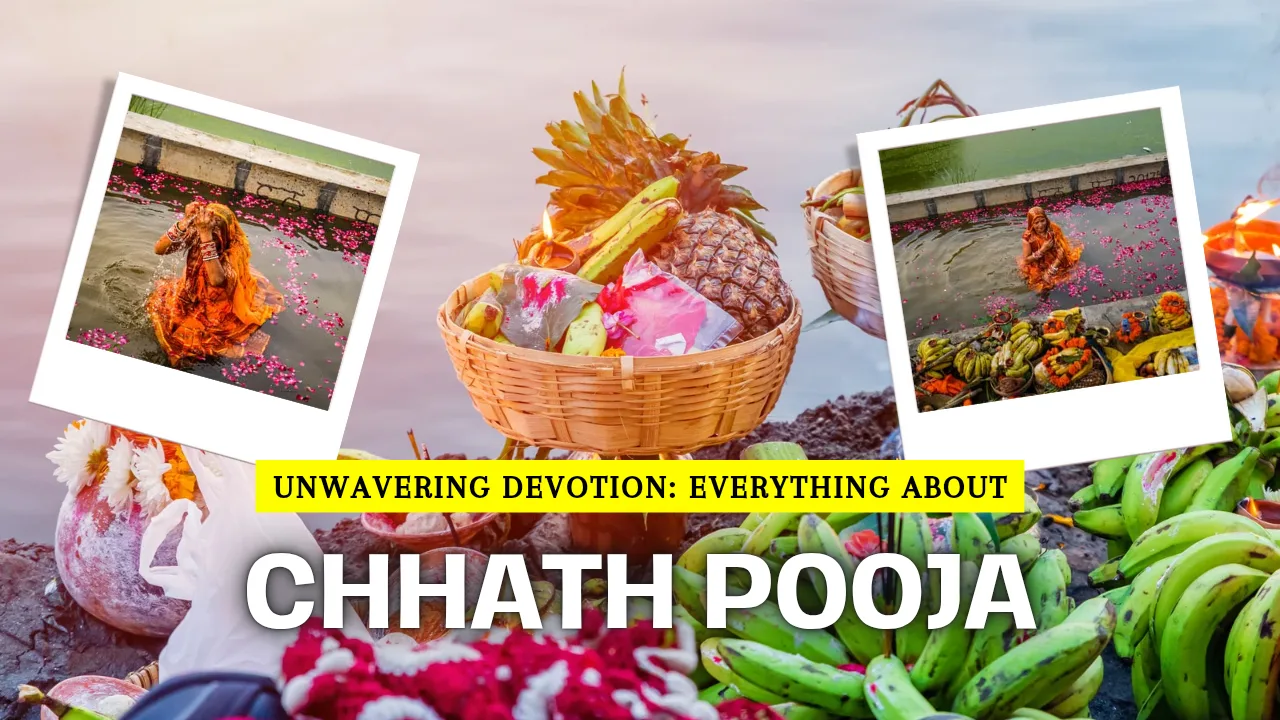The arrival of the post-Diwali season brings with it a unique and powerful expression of Hindu spirituality: Chhath Puja. More than just a festival, it is a four-day deep dive into austerity, purity, and profound connection with the Sun God, Surya, and his sister, Chhathi Maiya. Unlike most Hindu festivals where a single day is dedicated to a deity, Chhath demands a rigorous, continuous commitment, culminating in a 36-hour waterless fast.
In 2025, the grand celebration of this ancient Vedic festival will take place from Saturday, October 25, to Tuesday, October 28. For millions of devotees, this period is a sacred journey of gratitude, seeking blessings for prosperity, longevity, and the well-being of their children. If you’ve ever witnessed the captivating sight of thousands standing waist-deep in water, offering prayers to the setting and rising sun, you understand the magnitude of this event.
This post is your essential guide to understanding the dates, rituals, and the deep, human spirit of Chhath Puja 2025.
The Four Pillars of Chhath Puja 2025: Dates and Rituals
Chhath Puja is celebrated on the sixth day of the bright fortnight of the Hindu lunar month of Kartik. Each of the four days has distinct, non-negotiable rituals that build upon each other, emphasizing increasing self-restraint and purity.
Nahay Khay (Saturday, October 25, 2025)
The festival begins with an emphasis on purification. The term literally means “bathe and eat.”
- The Ritual: Devotees, or Vratis, take a holy bath, often in a river or pond, and then purify their homes.
- The Meal: The Vrati prepares and consumes a single, pure Satvik meal, typically consisting of rice, pulses like chana dal, and a pumpkin or bottle gourd (Lauki) curry cooked without onion or garlic. This food is prepared on a dedicated earthen stove or wood fire. This meal is the last time the Vrati will eat a proper meal until the third day.
Day 2: Kharna (Sunday, October 26, 2025)
This day is dedicated to a strict fast and a sacred evening offering.
- The Ritual: The Vrati observes a full-day fast (Nirjala Vrat – without water).
- The Evening Meal: After sunset, a special offering is made to Chhathi Maiya and the Sun God. The fast is broken with this prasad, which includes Rasiav (a sweet rice pudding made with jaggery) and buttered roti.
- The Vow Begins: Consuming this prasad marks the commencement of the rigorous 36-hour, continuous fast without a single drop of water, which lasts until the final Arghya on the fourth day.
Day 3: Sandhya Arghya (Monday, October 27, 2025)
The most iconic and visually stunning day, the evening offering to the setting sun.
- The Gathering: Families gather at the banks of rivers, ponds, or specially constructed makeshift water bodies.
- The Offering: The Vrati stands in the water, holding a Soop (bamboo winnowing basket) filled with traditional offerings (Prasad) towards the setting sun. These offerings universally include:
- Thekua: A sweet wheat-based cookie, the festival’s signature prasad.
- Sugarcane: Symbolizing growth and prosperity.
- Seasonal Fruits: Especially bananas and daab (water coconut).
- The Vow: This is the only major Hindu festival where the setting sun (Asta-cal-gami Surya) is worshipped, symbolizing gratitude for the life-giving energy that sustains us even as it recedes.
Day 4: Usha Arghya & Parana (Tuesday, October 28, 2025)
The final day concludes the fast and celebrates the rising sun.
- The Ritual: The Vrati and family return to the same water body before sunrise.
- The Conclusion: They offer a final Arghya (water and milk) to the rising sun (Uday-cal-gami Surya). This act symbolizes the renewal of life and the completion of the vow.
- Parana: After the offering, the Vrati breaks the 36-hour fast by consuming the prasad and taking a sip of the holy water (Charanamrit). The rest of the day is spent distributing prasad and celebrating the successful completion of the vrat.
Beyond Rituals: The Profound Significance of Chhath
Chhath Puja is a fascinating blend of Vedic science, mythological reverence, and grassroots environmentalism. The festival’s significance goes far deeper than a simple expression of devotion.
Also Read: Ignite the Twin Spirit: A Diwali Prompt for Gemini Boy
Scientific Basis and Spiritual Healing
Ancient Indian traditions often conceal scientific wisdom, and Chhath is a prime example. The rigorous routine, especially the prolonged fasting, is seen as a form of solar energy absorption therapy.
- Vitamin D Synthesis: Standing in the water during sunrise and sunset ensures that the body receives sunlight when UV radiation is minimal. Studies have shown that this period of sun exposure maximizes Vitamin D synthesis, which is vital for bone health and immunity—a crucial practice, particularly for women who are the primary Vratis.
- Detoxification: The Nirjala Vrat is a form of intensive spiritual and physical detoxification. The abstinence from food and water for 36 hours is believed to prepare the body to absorb the life-giving energy (Prana) directly from the sun, enhancing mental clarity and reducing negative energies.
An Eco-Friendly Festival
Chhath Puja is arguably one of the most eco-friendly religious festivals in the world. Its rituals are entirely devoted to nature:
- Water Body Cleanliness: Preparation for Chhath necessitates the thorough cleaning of riverbanks, ponds, and local water bodies, promoting civic environmental consciousness on a massive scale.
- Natural Offerings: The prasad and offerings are all natural—fruits, sugarcane, and thekua cooked using traditional methods. There is a complete absence of idols, toxic synthetic colours, or firecrackers.
Planning Your Chhath Puja 2025 Experience
Whether you are a Vrati, a family member supporting one, or an interested observer, preparing for Chhath Puja requires meticulous planning. The 2025 dates (Oct 25-28) provide a long weekend opportunity for many to travel home to cities like Patna, Ranchi, and Varanasi.
Essential Preparation Tips
- Travel Booking: Given the concentrated travel to the central celebration hubs in Eastern India, book your train or flight tickets immediately. This is one of the busiest travel periods of the year.
- Purity: Ensure the area where the prasad is prepared is pristine. New utensils, preferably made of bronze or clay, are often purchased and used exclusively for the four days.
- Samagri (Items) Checklist: Don’t wait until the last minute for items like the bamboo basket (daura), large quantities of sugarcane, turmeric root, and new cotton clothes.
Chhath Puja 2025 FAQs
Q1: When is the main day of Chhath Puja in 2025?
The main ritual day is Sandhya Arghya (Day 3), which falls on Monday, October 27, 2025.
This is the day when the offering is made to the setting sun. The conclusion, Usha Arghya, is on Tuesday, October 28.
Q2: What is the significance of the 36-hour Nirjala Vrat?
The Nirjala Vrat (fast without water) is a test of the Vrati’s immense devotion, discipline, and endurance. It is believed to be the ultimate form of austerity to cleanse the body and mind, paving the way for maximum spiritual and physical benefits from the sun’s energy.
Q3: Why is the setting sun worshipped during Chhath Puja?
Chhath is unique because it worships both the setting and rising sun. Worshipping the setting sun symbolizes the gratitude for what has been given, acknowledgment of the cycle of life, and the reverence for all forms of existence—not just the victorious or rising. It’s a deep philosophical concept of honoring both beginning and end.
Q4: Is Chhath Puja celebrated only by women?
While historically and predominantly observed by women (Vratis) for the well-being of their children and family, men increasingly observe the Chhath fast today. The festival is open to anyone seeking blessings and adhering to the strict rules of purity.
Q5: What is Thekua, and why is it so important?
Thekua is the signature prasad of Chhath Puja, a dry, sweet cookie made primarily from whole wheat flour, jaggery (or sugar), and clarified butter (Ghee). Its importance lies in its purity, long shelf-life (making it ideal for the four-day festival), and its symbolism of the Vrati’s devotion and home-cooked tradition.
Conclusion: A Celebration of Life and Light
Chhath Puja 2025 is more than a date on a calendar; it’s a timeless reaffirmation of our dependence on and gratitude for the natural world. It is a powerful narrative of discipline, purity, and the human spirit’s ability to endure and connect with the cosmic force of the Sun.
From the quiet purification of Nahay Khay to the collective, stunning devotion of the Sandhya Arghya at the water’s edge, this festival encapsulates the essence of ancient Indian spirituality. Embrace the light and the profound purity of this auspicious event.

















